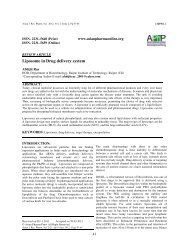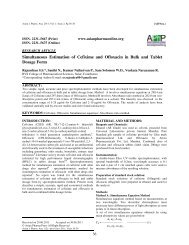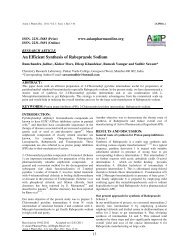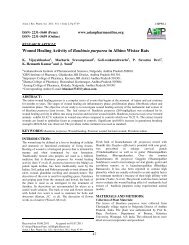Trichosanthes tricuspidata - asian pharma press
Trichosanthes tricuspidata - asian pharma press
Trichosanthes tricuspidata - asian pharma press
Create successful ePaper yourself
Turn your PDF publications into a flip-book with our unique Google optimized e-Paper software.
Asian J. Pharm. Tech. 2012; Vol. 2: Issue 1, Pg 26-28 [AJPTech.]<br />
ISSN- 2231–5705 (Print) www.<strong>asian</strong><strong>pharma</strong>online.org<br />
ISSN- 2231–5713 (Online) 0974-3618<br />
REVIEW ARTICLE<br />
<strong>Trichosanthes</strong> <strong>tricuspidata</strong>: Exploration of Its Medicinal Value<br />
Brijesh Kumar Duvey 1 *, Rohit Goyel 1 , Bharat Parashar 1 , Denesh Verma 1 , Hitesh Dhameja 1<br />
Dharmesh Sharma 2<br />
1 Department of Pharmacy, Manav Bharti University, Solan H.P.<br />
2 Department of Pharmacology, Himachal Dental College,Sunder Nagar<br />
*Corresponding Author E-mail: Brijesh.duvey@gmail.com<br />
ABSTRACT:<br />
India, with its great biodiversity about 15% out of the 20,000 medicinal plants of the world, has a tremendous potential<br />
and advantage in the emerging field of herbal medicines. Medicinal plants are the main sources of chemical substances<br />
with potential therapeutic effects. A lot of compounds were characterized from plants which are now using in the<br />
treatment of many diseases. The use of medicinal plants for the treatment of many diseases is associated with folk<br />
medicine from different parts of the world. Naturally occurring compounds from plants, fungi and microbes are still<br />
used in <strong>pharma</strong>ceutical preparations in pure or extracted forms about three hundred species are used by 7800 medicinal<br />
drug manufacturing units in India which consume about 2000 tons of herbs annually. There are estimated to be more<br />
than 717,319 registered practitioners of ayurveda, siddha, unani and homeopathy in India and in recent years, the<br />
growing demand for herbal products has led to the extinction of many important herbs because the drugs have no or<br />
very less side effect. <strong>Trichosanthes</strong> <strong>tricuspidata</strong> is a little-exploited plant with immense medicinal potential.<br />
Considering its importance, more research is necessitated to explore the potential of this plant.<br />
KEY WORDS: <strong>Trichosanthes</strong> <strong>tricuspidata</strong>, medicinal plant, trichosanthin, AIDS, antipyretic.<br />
INTRODUCTION:<br />
Ayurveda is conventional medicinal systems of Indian’s.<br />
Now the whole world is interested in India’s ayurveda and<br />
other traditional medicine systems. The demand of<br />
medicinal plants is increasing day by day in both<br />
developing as well as developed countries as a result of<br />
recognition of the non-narcotic nature, lack of side effects<br />
and easily availability of many herbal drugs. Most often the<br />
medicinal plants are collected from the wild(1). There are<br />
numerous data on the uses of medicinal plants. Gadgil and<br />
Vartak (2) have reported the uses of such plants in India.<br />
The therapeutic potential of various herbal plant have need<br />
to be explore for its medicinal use. In this present paper we<br />
have attempted to briefly summarize the information<br />
available on the potency of <strong>Trichosanthes</strong> <strong>tricuspidata</strong><br />
because of its immense medicinal potential it is a very<br />
important medicinal plant.(3)<br />
Received on 27.01.2012 Accepted on 12.03.2012<br />
© Asian Pharma Press All Right Reserved<br />
Asian J. Pharm. Tech. 2(1): Jan.-Mar. 2012; Page 26-28<br />
26<br />
Classification of <strong>Trichosanthes</strong> tricaspidata<br />
Kingdom Plantae<br />
Family Cucurbitceae<br />
Genus <strong>Trichosanthes</strong><br />
Species tricaspidata<br />
Authority Roxb.<br />
Synonym <strong>Trichosanthes</strong> palmate<br />
Common Name Lal indrayn, redball snakegourd
Asian J. Pharm. Tech. 2012; Vol. 2: Issue 1, Pg 26-28 [AJPTech.]<br />
Habit<br />
A large vigorous climber with tendrils. Its large, alternate<br />
leaves are palmately divided into three to seven lobes so<br />
called palmate, their petioles are reddish and stout. Its large<br />
white flowers have beautiful hair-like fringed petals. The<br />
fruit is a succulent, nearly globular gourd with a hard rind<br />
initially green but turn in red; its diameter is about 5-8 cm.<br />
Habitat<br />
T. <strong>tricuspidata</strong> is a cucurbitacian which is found at an<br />
elevation of 1200 to 2300 m. It ranges from Eastern<br />
Himalayas in India and southern China through southern<br />
Japan, Malaysia, and tropical Australia. In India it is a large<br />
climber, often attaining a height of 9-10 meters. It has a<br />
robust stem that is woody below, and has 3-cleft tendrils.<br />
The leaves are variable, palmately 3-5 lobed with a cordate<br />
base, and the lobes are ovate to oblong with serrate or<br />
dentate margins. Male flowers are in axillary 5-10 flowered<br />
racemes with large bracts, while the female flowers are<br />
solitary. The corolla petals are wedge-shaped, fringed and<br />
white in color. The fruits are globose, and when ripe are red<br />
with ten orange streaks.<br />
Uses<br />
T. <strong>tricuspidata</strong> is very important medicinal plant in several<br />
traditional systems. In ayurvedic medicines systems, the<br />
fruits are used in the treatment of asthma, earache and<br />
ozoena (intranasal crusting, atrophy and fetid odor). In the<br />
Unani system of medicine, the fruits are used as a<br />
carminative (an agent that relieves flatulence), a purgative,<br />
and an abortifacient, to lessen inflammation, cure<br />
migraines, and reduce heat of the brain, as a treatment for<br />
opthalmia (inflammation of the eye), leprosy (infectious<br />
disease caused by Mycobacterium leprae), epilepsy<br />
(episodic impairment or loss of consciousness, abnormal<br />
motor phenomenon) and rheumatism, (painful local<br />
inflammation of joints and muscles) as well as other uses.<br />
The seeds are emetic and a good purgative (4). The roots of<br />
the plant are used to treat lung diseases in cattle and for the<br />
treatment of diabetic carbuncles and headaches (5). Gaur<br />
(6) has reported the use of this plant in curing bronchitis,<br />
and the application of seed paste for hoof and mouth<br />
disease in cattle.<br />
27<br />
The vaidyas, or practictioners of ayurveda, also use the<br />
fruits in treating stomatitis. The oil extracted from the roots<br />
is used as a pain killer. In Bastar District, Chhattisgarh,<br />
India, the plant is used for curing snakebite poisoning and<br />
the juice of the plant is applied externally for skin eruptions.<br />
In Nepal the roots are used to cure bleeding in chickens.<br />
Chemical constituents<br />
Mohamed (7) isolated a tetrahydroxy pentacyclic triterpene<br />
“trichotetrol” from the root extract of T. <strong>tricuspidata</strong>. And<br />
from the fruits of T. <strong>tricuspidata</strong>, 14 cucurbitane glycosides<br />
were isolated (8). An extract of the fruits of this plant was<br />
found to be cytotoxic in KB cells, and two new<br />
cucurbitacins were tricuspidatin and 2-O-glucocucurbitacin<br />
J also reported(9). Kaneda and Uchikoba (10) reported a<br />
protease from the sarcocarp of the fruits of this plant. The<br />
root contains methyl palmitate, palmitic acid, suberic acid,<br />
-spinasterol, stigmast-7-en-3-beta-ol, -spinasterol 3-obeta-D-glucopyranoside,<br />
stigmast-7-en-3-beta-ol-3-O-beta-<br />
D-glucopyranoside, glyceryl 1-palmitate,glyceryl 1-stearate,<br />
bryonolic acid, cucurbitacin B, isocucurbitacin B, 3-epiisocucurbitacin<br />
B, 23,24-dihydrocucurbitacin D,<br />
isocucurbitacin D and D-glucose. The roots of T.<br />
<strong>tricuspidata</strong> contain more than 6 times more cucurbitacin<br />
than the roots of T. kirilowii Maxim. Var. japonicum Kitam.<br />
(11). Kasai et.al., (12) isolated 3 new cycloartane<br />
glycosides, named cyclotricuspidosides A, B and C, from<br />
the leaf and stem parts.<br />
Medicinal use<br />
According to Encyclopaedia of Herbs and their<br />
Uses (Dorling Kindersley, London, 1995), recent research<br />
has isolated a protein called 'trichosanthin' in the roots and<br />
this is undergoing trials as a possible remedy for AIDS.<br />
Antipyretic Antibacterial, anticholesterolemic, antifungal,<br />
antiinflammatory, antitussive, cancer, emollient,<br />
Expectorant, uterine tonic, oxytoic,galactogogue etc. The<br />
fruit can inhibit Staphylococcus aureus, Diplococcus<br />
pneumoniae, hemolytic streptococcus, Bacillus pyocyaneus,<br />
Bacillus influenzae, Bacillus dysenteriae, B. typhi, B.<br />
paratyphi, E. coli, pseudomonas, Vibrio cholerae, V.<br />
proteus, etc. The fruit is traditionally prepared as a winter<br />
soup to ward off colds and influenza. (13)<br />
Ethanolic extract of Tricosanthes <strong>tricuspidata</strong> Linn have<br />
antipyretic activity (12)<br />
According to famous physician, “Clears obstruction of the<br />
chest , making the human face look pleasant and lustrous.”<br />
The Compendium of Material Medica “Moisturizing the<br />
lungs, removing fire in the lungs, arresting coughing,<br />
washing away phlegm stagnated in the chest, relieving sore<br />
throat, curing diabetes, lubricating the large intestine and<br />
healing skin and external diseases.”(15)<br />
The Narration of Materia Medica : "<strong>Trichosanthes</strong> fruit<br />
(Fructus Trichosanthis) is fluid, thick, fatty and moistening,<br />
so it is an herb to deal with the stagnation of phlegm due to<br />
heat and dryness. Therefore it is used for cold-phlegm,
Asian J. Pharm. Tech. 2012; Vol. 2: Issue 1, Pg 26-28 [AJPTech.]<br />
damp-phlegm, phlegm stagnated due to qi deficiency and<br />
phlegm accumulated due to food stagnancy, all of which are<br />
harmful with no benefit."(14)<br />
CONCLUSION:<br />
After the searching lot of literature and paper related to this<br />
plant I have found that it have so much medicinal properties<br />
like it may have anti-HIV activity, antibacterial,<br />
anticholesterolemic, antifungal, anti-inflammatory,<br />
antitussive, cancer, emollient, Expectorant, uterine tonic,<br />
etc. except this, it also have antipyretic activity so more<br />
research work is required to explore the medicinal value of<br />
this plant.<br />
ACKNOWLEDGEMENT:<br />
I would like to say thanks to Dr. S. P. Bhardwase (V.C.) of<br />
Manav Bharti University, Solan H.P. who give us<br />
continuous support and direction to write this review article,<br />
I would also like to give my regards the library staff of<br />
Manav Bharti University and Dr. Y S. Parmar University,<br />
Nouni, H.P. who provided related information on this plant<br />
and the last but not least Special thanks to Dr. Rajesh for<br />
identification and authentication of the plant.<br />
REFERENCES:<br />
1. Kala CP, PP Dhyani and BS Sajwan (2006) Developing the<br />
medicinal plants sector in northern India: challenges and<br />
opportunities. Journal of Ethnobotany and Ethnomedicine 2:32.<br />
doi: 10.1186/1746-4269-2-32<br />
2. Sadangi N, RN Padhy and RK Sahu (2005) A contribution to<br />
medico-ethnobotany of Kalahandi District, Orissa on ear and<br />
mouth disease. Ancient Science of Life 24(3):160-163.<br />
3. Gadgil M and VD Vartak (1981) Studies on sacred groves along<br />
the Western Ghats from Maharashtra and Goa: role of beliefs and<br />
folklore. In: SK Jain (ed.) Glimpses of Indian Ethnobotany. New<br />
Delhi: Oxford and IBH Publishing Co. 272-278<br />
4. Kanchanapoom T, K Ryoji and K Yamasaki (2002) Cucurbitane,<br />
hexanorcucurbitane and octanorcucurbitane glycosides from<br />
fruits of <strong>Trichosanthes</strong> <strong>tricuspidata</strong>. Phytochemistry 59:215-228.<br />
5. Chopra RN, SN Nayar and TC Chopra (1956) Glossary of Indian<br />
Medicinal Plants. New Delhi: Council of Scientific and Industrial<br />
Research. 247.<br />
6. Gaur RD (1999) Flora of the District Garhwal North West<br />
Himalaya. Srinagar, Uttarakhand (India): Transmedia Publishers.<br />
811.<br />
7. Mohamed PA (1974) Isolation of “Trichotetrol”—A new<br />
tetrahydroxy pentacyclic triterpene from <strong>Trichosanthes</strong> bracteata<br />
(Cucurbitaceae). Linn.,Voight. Syn. T. palmata (Roxb.). Current<br />
Science 43:116.<br />
8. Mai le P, D Guenard, M Franck, TM Van, C Gaspard and T<br />
Sevenet (1994) New cytotoxic cucurbitacins from the pericarps of<br />
<strong>Trichosanthes</strong> <strong>tricuspidata</strong> fruits. Natural Product Letters<br />
16(1):15-19<br />
9. Kaneda M and T Uchikoba (1994) Protease from the sarcocarp of<br />
<strong>Trichosanthes</strong> bracteata. Phytochemistry 35(3):583-586.<br />
10. Kitajima J, A Mukai, Y Masuda and Y Tanaka (1989) Studies on<br />
the constituents of <strong>Trichosanthes</strong> root. III. Constituents of roots<br />
of <strong>Trichosanthes</strong> bracteata Voight. Yakugaku Zasshi 109(4):265-<br />
270. (Japanese)<br />
11. Evaluation of Anti-Pyretic Effect of <strong>Trichosanthes</strong> <strong>tricuspidata</strong><br />
Linn on Albino Rats Vol. 2(4) Oct - Dec 2011<br />
www.ijrpbsonline.com<br />
12. Kasai R, A Sasaki, T Hashimoto, K Ohtani and K Yamasaki<br />
(1999) Cycloartane glycosides from <strong>Trichosanthes</strong> <strong>tricuspidata</strong>.<br />
Phytochemistry 51:803-808.<br />
28<br />
13. http://www.e2121.com/herb_db/viewherb.php3?viewid=442ands<br />
etlang=<br />
14. ENaturalHealthCenter.com (e2121.com<br />
15. Singh HP (2001) National perspective on development of<br />
medicinal and aromatic plants. Technical report. AgriWatch.<br />
http://www.agriwatch.com

















